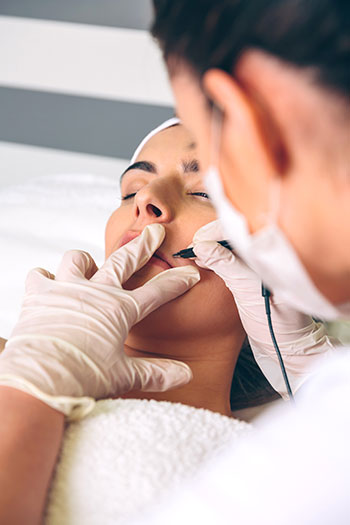 Radio frequency (RF) devices have been used in the health-care industry for more than 50 years. They assist surgeons in cauterizing tissue and reducing blood loss. They are also the basis of magnetic resonance imaging (MRI). In 2000, the use of RF devices was adopted by the beauty industry and became FDA-approved for skin tightening.
Radio frequency (RF) devices have been used in the health-care industry for more than 50 years. They assist surgeons in cauterizing tissue and reducing blood loss. They are also the basis of magnetic resonance imaging (MRI). In 2000, the use of RF devices was adopted by the beauty industry and became FDA-approved for skin tightening.
Over time, devices have been modified to meet various skin care needs. Beyond skin tightening, RF is FDA-approved for cellulite and fat reduction, skin resurfacing, and to remove minor skin abnormalities such as skin tags. The popularity of this modality is due to its efficiency, safety, and versatility.
What are radio frequency treatments?
RF is an alternating current with treatment outcomes similar to laser and light energy. One of the main advantages to RF, however, is that it does not target a chromophore (the part of a molecule responsible for color). In the epidermis and dermis, the chromophore absorbs a laser beam’s energy, which leads to a controlled wound. Since RF is “color-blind,” treatments are acceptable for use on all Fitzpatrick skin types, with minimal chance for hypo- or hyperpigmentation. Application of RF can be delivered in a variety of ways. Here, we’ll focus on the use of RF for minor skin abnormalities.
How does radio frequency technology work?
Treatments that use RF technology to target skin flaws are also known as thermocoagulation, electrocauterization, and electrodesiccation. Without penetrating the skin’s surface, these devices create localized heat that evaporates the targeted tissues’ fluid and blocks blood supply. The result is either coagulation of the tissue or blanching of a vascular lesion. This is accomplished with a needle-thin electrode that is placed near the targeted lesion, allowing electric current to be conducted and heat to be produced in pinpoint-precise areas.
After the lesion is treated, a small crust or scab will form, which falls away within 4–7 days. Immediately after treatment, the skin may be a little red or flushed. Remind clients it’s best not to pick or scratch at any scabs in order to avoid scarring. Makeup can be applied within 24 hours.
Contraindications for radio frequency
Electrodesiccation devices are used for treating a wide range of skin irregularities, including skin tags, milia, sebaceous hyperplasia, xanthomas, angiomas, blocked pores, fibromas, and spider veins.
When in doubt, don’t treat. If you have a client with a suspicious-looking lesion, refer them to their medical provider. Never attempt to diagnose skin lesions, even when prompted for your opinion by the client. Always refer your client to their medical provider. Clients who are contraindicated for treatment include those with a pacemaker, epilepsy, uncontrolled diabetes, open wounds, pregnancy, and autoimmune disease, among others. Always follow the directions of your medical director or place of business. In some scenarios, you may treat with caution, but protect your client and yourself by requesting that your client receives written approval from their medical provider before proceeding.
Radio frequency training
Devices can be classified as Class I or Class II devices and may require medical supervision. Be sure you have had proper hands-on training and know the regulations in your state. In some states, a Class II device may be outside your scope of practice.
Consider that most estheticians are not allowed to perform ablative skin procedures, such as those that remove, cut, or vaporize skin tissue, without medical supervision. Even then, this may not be within your scope of practice. There are many types of devices on the market and not all devices use RF; some use high frequency but with the same intended outcome. If too much heat is applied to the skin, this can lead to tissue damage with the chance for scarring and pigmentation.
Training in RF is usually not incorporated into a basic esthetics course and requires advanced education. In some instances, the manufacturer of the device you are purchasing will provide training; however, be sure that this training will qualify you for insurance coverage. When looking for a training center, search for one that provides a comprehensive understanding of the modality as well as hands-on practical application.
Liability Insurance for radio frequency
- Log in to post comments

Comments
RF form
Hi friends,
I would like to know if you have any special form for facial radiofrequency treatment.
Regards,
Nathalie Conde-Jahn
RE: RF FORM
Hi Nathalie,
ASCP does have special forms for Radio Frequency treatments! This is an exclusive ASCP member benefit and can be accessed here (in addition to 50+ other specialized forms): www.ascpskincare.com/members/business-building/treatment-forms.
Emily Morgan (ASCP Membership Program Manager)